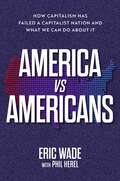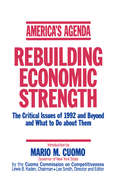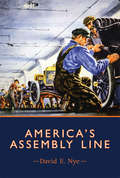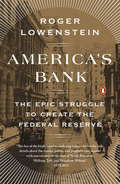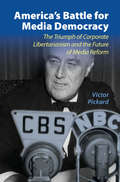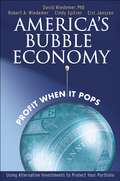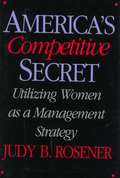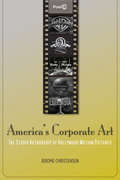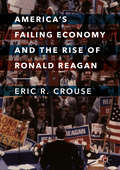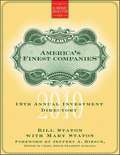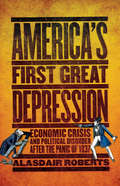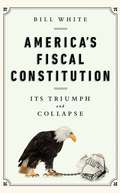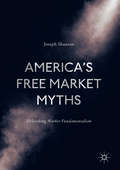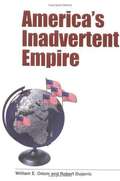- Table View
- List View
America vs. Americans: How Capitalism Has Failed a Capitalist Nation and What We Can Do About It
by Eric WadeIn America vs. Americans, Eric Wade presents American Laborism, a revolutionary new economic system, where the greatest commodity isn&’t cash, it&’s work.Capitalism is broken. Despite its successes, capitalism gives us the largest wealth gap in American history, failing Social Security, a weak currency, and a looming threat of AI destroying our workforce. We need a new system—one built around people rather than capital. A system that values each person&’s unique contribution, ingenuity, and hard work—their labor. A system in which the greatest commodity isn&’t cash; it&’s work. And a system in which Americans at every level of society and government are working together. We need American Laborism, a revolutionary new system that presents a workable, low-tax form of capitalism for those who want it—and a dignified, healthy, happy, and fulfilled life for everyone else. Under American Laborism, if you&’re happy with the current capitalist system, great! Carry on—but you&’ll get to do it with a smaller government, fewer regulations, better-educated employees, and lower taxes. And if capitalism hasn&’t worked out as well for you, you get access to unlimited free education and training, guaranteed housing and food, and a sound asset-backed currency. Everybody wins! American Laborism isn&’t just a replacement for capitalism. It&’s an upgrade. Every American has the right to live a life of dignity, to contribute, and to ensure that their basic needs are respected by their society. American Laborism can improve the lives of every American by bringing the least among us up . . . without bringing anyone else down. It&’s time to heal our nation. It&’s time for American Laborism.
America's Agenda: Rebuilding Economic Strength
by Mario M. Cuomo The Cuomo Commission on CompetitivenessCuomo's Commission on Competitiveness argues that America must reform its economic and social policies and institutions to reverse the weakening of its industrial leadership, the erosion of living standards and escalating social problems. Topics include public investment, urban poverty, health care, the environment, fiscal policy and international strategies.
America's Assembly Line
by David E. NyeFrom the Model T to today's "lean manufacturing": the assembly line as crucial, yet controversial, agent of social and economic transformation.The mechanized assembly line was invented in 1913 and has been in continuous operation ever since. It is the most familiar form of mass production. Both praised as a boon to workers and condemned for exploiting them, it has been celebrated and satirized. (We can still picture Chaplin's little tramp trying to keep up with a factory conveyor belt.) In America's Assembly Line, David Nye examines the industrial innovation that made the United States productive and wealthy in the twentieth century.The assembly line—developed at the Ford Motor Company in 1913 for the mass production of Model Ts—first created and then served an expanding mass market. It also transformed industrial labor. By 1980, Japan had reinvented the assembly line as a system of “lean manufacturing”; American industry reluctantly adopted the new approach. Nye describes this evolution and the new global landscape of increasingly automated factories, with fewer industrial jobs in America and questionable working conditions in developing countries. A century after Ford's pioneering innovation, the assembly line continues to evolve toward more sustainable manufacturing.
America's Bank
by Roger LowensteinA tour de force of historical reportage, America's Bank illuminates the tumultuous era and remarkable personalities that spurred the unlikely birth of America's modern central bank, the Federal Reserve. Today, the Fed is the bedrock of the financial landscape, yet the fight to create it was so protracted and divisive that it seems a small miracle that it was ever established. For nearly a century, America, alone among developed nations, refused to consider any central or organizing agency in its financial system. Americans' mistrust of big government and of big banks--a legacy of the country's Jeffersonian, small-government traditions--was so widespread that modernizing reform was deemed impossible. Each bank was left to stand on its own, with no central reserve or lender of last resort. The real-world consequences of this chaotic and provincial system were frequent financial panics, bank runs, money shortages, and depressions. By the first decade of the twentieth century, it had become plain that the outmoded banking system was ill equipped to finance America's burgeoning industry. But political will for reform was lacking. It took an economic meltdown, a high-level tour of Europe, and--improbably--a conspiratorial effort by vilified captains of Wall Street to overcome popular resistance. Finally, in 1913, Congress conceived a federalist and quintessentially American solution to the conflict that had divided bankers, farmers, populists, and ordinary Americans, and enacted the landmark Federal Reserve Act.Roger Lowenstein--acclaimed financial journalist and bestselling author of When Genius Failed and The End of Wall Street--tells the drama-laden story of how America created the Federal Reserve, thereby taking its first steps onto the world stage as a global financial power. America's Bank showcases Lowenstein at his very finest: illuminating complex financial and political issues with striking clarity, infusing the debates of our past with all the gripping immediacy of today, and painting unforgettable portraits of Gilded Age bankers, presidents, and politicians.Lowenstein focuses on the four men at the heart of the struggle to create the Federal Reserve. These were Paul Warburg, a refined, German-born financier, recently relocated to New York, who was horrified by the primitive condition of America's finances; Rhode Island's Nelson W. Aldrich, the reigning power broker in the U.S. Senate and an archetypal Gilded Age legislator; Carter Glass, the ambitious, if then little-known, Virginia congressman who chaired the House Banking Committee at a crucial moment of political transition; and President Woodrow Wilson, the academician-turned-progressive-politician who forced Glass to reconcile his deep-seated differences with bankers and accept the principle (anathema to southern Democrats) of federal control. Weaving together a raucous era in American politics with a storied financial crisis and intrigue at the highest levels of Washington and Wall Street, Lowenstein brings the beginnings of one of the country's most crucial institutions to vivid and unforgettable life. Readers of this gripping historical narrative will wonder whether they're reading about one hundred years ago or the still-seething conflicts that mark our discussions of banking and politics today. From the Hardcover edition.
America's Bank: The Epic Struggle to Create the Federal Reserve
by Roger LowensteinA tour de force of historical reportage, America's Bank illuminates the tumultuous era and remarkable personalities that spurred the unlikely birth of America's modern central bank, the Federal Reserve. Today, the Fed is the bedrock of the financial landscape, yet the fight to create it was so protracted and divisive that it seems a small miracle that it was ever established. For nearly a century, America, alone among developed nations, refused to consider any central or organizing agency in its financial system. Americans' mistrust of big government and of big banks--a legacy of the country's Jeffersonian, small-government traditions--was so widespread that modernizing reform was deemed impossible. Each bank was left to stand on its own, with no central reserve or lender of last resort. The real-world consequences of this chaotic and provincial system were frequent financial panics, bank runs, money shortages, and depressions. By the first decade of the twentieth century, it had become plain that the outmoded banking system was ill equipped to finance America's burgeoning industry. But political will for reform was lacking. It took an economic meltdown, a high-level tour of Europe, and--improbably--a conspiratorial effort by vilified captains of Wall Street to overcome popular resistance. Finally, in 1913, Congress conceived a federalist and quintessentially American solution to the conflict that had divided bankers, farmers, populists, and ordinary Americans, and enacted the landmark Federal Reserve Act.Roger Lowenstein--acclaimed financial journalist and bestselling author of When Genius Failed and The End of Wall Street--tells the drama-laden story of how America created the Federal Reserve, thereby taking its first steps onto the world stage as a global financial power. America's Bank showcases Lowenstein at his very finest: illuminating complex financial and political issues with striking clarity, infusing the debates of our past with all the gripping immediacy of today, and painting unforgettable portraits of Gilded Age bankers, presidents, and politicians.Lowenstein focuses on the four men at the heart of the struggle to create the Federal Reserve. These were Paul Warburg, a refined, German-born financier, recently relocated to New York, who was horrified by the primitive condition of America's finances; Rhode Island's Nelson W. Aldrich, the reigning power broker in the U.S. Senate and an archetypal Gilded Age legislator; Carter Glass, the ambitious, if then little-known, Virginia congressman who chaired the House Banking Committee at a crucial moment of political transition; and President Woodrow Wilson, the academician-turned-progressive-politician who forced Glass to reconcile his deep-seated differences with bankers and accept the principle (anathema to southern Democrats) of federal control. Weaving together a raucous era in American politics with a storied financial crisis and intrigue at the highest levels of Washington and Wall Street, Lowenstein brings the beginnings of one of the country's most crucial institutions to vivid and unforgettable life. Readers of this gripping historical narrative will wonder whether they're reading about one hundred years ago or the still-seething conflicts that mark our discussions of banking and politics today. From the Hardcover edition.
America's Battle for Media Democracy
by Victor PickardHow did the American media system become what it is today? Why do American media have so few public-interest regulations compared with other democratic nations? How did the system become dominated by a few corporations, and why are structural problems like market failures routinely avoided in media-policy discourse? By tracing the answers to many of these questions back to media-policy battles in the 1940s, this book explains how this happened and why it matters today. Drawing from extensive archival research, the book uncovers the American media system's historical roots and normative foundations. It charts the rise and fall of a forgotten media-reform movement to recover alternatives and paths not taken. As much about the present and future as it is about the past, the book proposes policies for remaking media based on democratic values for the digital age.
America's Bubble Economy
by Eric Janszen David Wiedemer Robert Wiedemer Cindy SpitzerAmerica's Bubble Economy is the first book to focus on several simultaneous financial bubbles that are interacting to temporarily boost-and ultimately threaten-the United States and world economies. Filled with expert analysis and straight talk, this book will show you how to turn the coming economic transformation into a once-in-a-lifetime wealth-building opportunity.
America's Budget Impasse
by Richard H.K. VietorAmerica's Budget Impasse draws on a series of recent government documents to explore America's recent economic performance, President Obama's Budget strategy and the budget proposals of the Republican Senate and House Budget Committees. Using the Economic Reports of the President for 2014 and 2015 and the Budget of the United States for FY 2016, the case summarizes where we've recently been economically, with the Bush tax cuts and Obama's stimulus, where we are today and where President Obama would like us to go. For contrast, it also summarizes Senator Enzi's budget proposal and Congressman Price's budget proposal - the chairs of the Senate and House Budget Committees.
America's Budget Impasse, 2001-2019
by Richard H.K. VietorAmerica's Budget Impasse, 2001-2019 draws on recent government documents to explore America's economic performance since 2001, the ideology and effects of the Bush tax cuts, Obama's fiscal stimulus in 2009, the Trump tax cuts in 2017, the bipartisan budget deal in 2018, and President Trump's budget proposal for FY2019.
America's Budget Impasse, 2001-2020
by Richard H.K. VietorAmerica's Budget Impasse, 2001-2020, draws on recent government documents to explore America's economic performance since 2001, the ideology and effects of the Bush tax cuts, Obama's fiscal stimulus in 2009, the Trump tax cuts in 2017, and President Trump's budget proposal for FY2020.
America's Cheapest Family Gets You Right on the Money: Your Guide to Living Better, Spending Less, and Cashing In on Your Dreams
by Annette Economides Steve EconomidesDo you have too much month at the end of your money? Is your credit card screaming for relief? Are you tired of robbing Peter to pay Paul . . . whoever they are? Meet Steve and Annette Economides. They've been called cheapskates, thriftaholics, and tightwads, but in these tough economic times, Steve and Annette have managed to feed their family of seven on just $350 per month, pay off their first house in nine years and purchase a second, larger home, buy cars with cash, take wonderful vacations, and put money in savings. Without degrees in finance or six-figure salaries, Steve and Annette have created a comfortable, debt-free life for themselves and their children. In America's Cheapest Family Gets You Right on the Money, they show you how they did it and how you can do it too. Steve and Annette share many down-to-earth principles and the simple spending plan that they have used since 1982. They have taught this economizing lifestyle to thousands of people worldwide through seminars and their newsletter, and they include lots of real-life stories to make you feel as if you're having your own private coaching session. Not only will you find solutions to your financial dilemmas, you'll also discover a whole new way of life. You don't need to be a CPA or a math wizard to learn their revolutionary system, which will teach you: - hundreds of ways to save money on everyday household expenses, including groceries, clothing, and health care - how to save in advance for major purchases such as homes, cars, and vacations - how to stop living paycheck to paycheck - how to eliminate debt forever! America's Cheapest Family Gets You Right on the Money puts meeting your financial goals, and living well at the same time, in reach for every family.
America's Competitive Secret
by Judy B. RosenerThe United States has a large number of well educated, experienced professional women ready, willing and able to move into the boardrooms and executive suites of corporate America. Together they represent a great, untapped economic resource, a resource no other country in the world can claim.This is America's competitive secret, argues Judy B. Rosener in this refreshingly pragmatic new book for managers who want to improve their bottom line. A leading expert on women and men at work and a highly sought-after speaker, Rosener argues that not only are men and women different, so are male and female managers. Drawing on in-depth interviews with top-flight executives and middle managers and the latest research on working women andorganizational change, she describes the unique contribution of female professionals. Her profiles of top women managers reveal that they cope well with ambiguity, are comfortable sharing power, and they tend to empower others-- leadership traits that Rosener contends lead to increased employeeproductivity, innovation, and profits. As businesses today struggle with corporate reorganization and an increasingly diverse workforce, America's Competive Secret offers compelling evidence that the changes that help organizatiions more fully utilize the talents of women are the same changes thatwill give them an important edge in today's fast-changing, service oriented, global workplace. Rosener explains why the so-called glass ceiling still prevents many competent women from reaching the upper echelons of management. She analyzes why women and men are perceived and evaluated differently at work, and provides new insight into the feelings of men who are asked to interact with womenin new roles when there are few new rules. Rosener shows that removing the glass ceiling can no longer be viewed solely in terms of social equity--it is now an economic imperative. Too many American businesses have limited their economic strength by viewing the promotion of women employees only within the context of federally mandated affirmative action laws and policies. America's Competitive Secret redefines the issue for a new era, showing that America's most successfulcompetitive strategy is one that most effectively utilizes all its human resources.
America's Corporate Art: The Studio Authorship of Hollywood Motion Pictures (1929-2001)
by Jerome ChristensenContrary to theories of single person authorship, America's Corporate Art argues that the corporate studio is the author of Hollywood motion pictures, both during the classical era of the studio system and beyond, when studios became players in global dramas staged by massive entertainment conglomerates. Hollywood movies are examples of a commodity that, until the digital age, was rare: a self-advertising artifact that markets the studio's brand in the very act of consumption. The book covers the history of corporate authorship through the antithetical visions of two of the most dominant Hollywood studios, Warner Bros. and MGM. During the classical era, these studios promoted their brands as competing social visions in strategically significant pictures such as MGM's Singin' in the Rain and Warner's The Fountainhead. Christensen follows the studios' divergent fates as MGM declined into a valuable and portable logo, while Warner Bros. employed Batman, JFK, and You've Got Mail to seal deals that made it the biggest entertainment corporation in the world. The book concludes with an analysis of the Disney-Pixar merger and the first two Toy Story movies in light of the recent judicial extension of constitutional rights of the corporate person.
America's Cup in 2013: Oracle Team USA vs. Emirates Team New Zealand (A)
by Alan Maccormack Rory Mcdonald Vanessa AmpelasFour teams across the world are furiously designing, building, testing, and learning to sail a boat that would be one-of-a-kind, in order to win the 2013 America's Cup. Choosing the best development path was a challenge as the teams had less than three years to prepare, and each decision would affect the performance of the boat as well as the duration of the sailors' training. The case traces the dilemma faced by the favorite, ORACLE TEAM USA (OTUSA), as rumors grew that the challenger was pursuing a revolutionary technology that would enable its six-ton boat to literally fly above waves. With only a year left before the Cup, should OTUSA keep refining its current technology called "skimming", or should it pivot towards "foiling" (flying)? At this stage "foiling" could be a red herring, and even if it was not, the limits of the performance of a foiling boat would remain a mystery for some time. The case explores the dilemma of managing innovation in an uncertain environment, where the decision would be sanctioned a year later by a win or a loss.
America's Cup in 2013: Oracle Team USA vs. Emirates Team New Zealand (A)
by Alan Maccormack Rory Mcdonald Vanessa AmpelasFour teams across the world are furiously designing, building, testing, and learning to sail a boat that would be one of a kind, in order to win the 2013 America's Cup. Choosing the best development path was a challenge as the teams had less than three years to prepare, and each decision would affect the performance of the boat as well as the duration of the sailors' training. The case traces the dilemma faced by the favorite, ORACLE TEAM USA (OTUSA), as rumors grew that the challenger was pursuing a revolutionary technology that would enable its six-ton boat to literally fly above waves. With only a year left before the Cup, should OTUSA keep refining its current technology called "skimming", or should it pivot towards "foiling" (flying)? At this stage foiling could be a red herring, and even if it was not, the limits of the performance of a foiling boat would remain a mystery for some time. The case explores the dilemma of managing innovation in an uncertain environment, where the decision would be sanctioned a year later by a win or a loss.
America's Economic Way of War: War and the US Economy from the Spanish-American War to the First Gulf War
by Hugh RockoffHow did economic and financial factors determine how America waged war in the twentieth century? This important new book exposes the influence of economics and finance on the questions of whether the nation should go to war, how wars would be fought, how resources would be mobilized, and the long-term consequences for the American economy. Ranging from the Spanish-American War to the Gulf War, Hugh Rockoff explores the ways in which war can provide unique opportunities for understanding the basic principles of economics as wars produce immense changes in monetary and fiscal policy and so provide a wealth of information about how these policies actually work. He shows that wars have been more costly to the United States than most Americans realize as a substantial reliance on borrowing from the public, money creation and other strategies to finance America's war efforts have hidden the true cost of war.
America's Economic Way of War: War and the US Economy from the Spanish-American War to the Persian Gulf War
by Hugh RockoffHow did economic and financial factors determine how America waged war in the twentieth century? This important new book exposes the influence of economics and finance on the questions of whether the nation should go to war, how wars would be fought, how resources would be mobilized, and the long-term consequences for the American economy. Ranging from the Spanish-American War to the Gulf War, Hugh Rockoff explores the ways in which war can provide unique opportunities for understanding the basic principles of economics as wars produce immense changes in monetary and fiscal policy and so provide a wealth of information about how these policies actually work. He shows that wars have been more costly to the United States than most Americans realize as a substantial reliance on borrowing from the public, money creation and other strategies to finance America's war efforts have hidden the true cost of war.
America's Failing Economy and the Rise of Ronald Reagan
by Eric R. CrouseThis book examines one of the most important economic outcomes in American history—the breakdown of the Keynesian Revolution. Drawing on economic literature, the memoirs of economists and politicians, and the popular press, Eric Crouse examines how economic decline in the 1970s precipitated a political revolution. Keynesian thought flourished through the presidencies of Lyndon B. Johnson, Richard Nixon, and Gerald Ford, until stagflation devastated American workers and Jimmy Carter’s economic policies faltered, setting the stage for the 1980 presidential campaign. Tracking years of shifting public opinion and colorful debate between free-market and Keynesian economists, this book illuminates a neglected era of American economic history and shows how Ronald Reagan harnessed a vision of small government and personal freedom that transformed the American political landscape.
America's Finest Companies 2010
by Bill Staton Hirsch Mary StatonA detailed look at the best American companies to invest inAmerica's Finest Companies 2010 (now in its 19th annual edition) is a reliable guide to investing, containing every publicly traded company in the United States with at least ten consecutive years of higher dividends and/or earnings per share.With this detailed directory, Bill Staton--a successful financial advisor and money manager for almost four decades--shares his simple, time-tested way to make your money grow at an above-average rate with substantially reduced risk. The companies found here are well-run and profitable, and with long histories of rising annual dividends and/or earnings, they are sure to boost the bottom line of any portfolio.Offers essential insights into building a portfolio of American companies with rising annual dividends and/or earningsContains new listings and delistings as well as a break down of companies by industryFilled with thoughtful editorial pieces such as "Dow 30,000 by 2018", "Trends Don't Go On Forever", and "Turning Chaos Into Tremendous Opportunity"America's Finest Companies 2010 will help you rebuild your portfolio and keep it on sound financial footing for years to come. If you're looking to invest successfully, look no further than America's Finest Companies 2010.
America's First Great Depression: Economic Crisis and Political Disorder after the Panic of 1837
by Alasdair RobertsFor a while, it seemed impossible to lose money on real estate. But then the bubble burst. The financial sector was paralyzed and the economy contracted. State and federal governments struggled to pay their domestic and foreign creditors. Washington was incapable of decisive action. The country seethed with political and social unrest. In The First Great Depression, Alasdair Roberts describes how the United States dealt with the economic and political crisis that followed the Panic of 1837. As Roberts shows, the two decades that preceded the Panic had marked a democratic surge in the United States. However, the nation's commitment to democracy was tested severely during this crisis. Foreign lenders questioned whether American politicians could make the unpopular decisions needed on spending and taxing. State and local officials struggled to put down riots and rebellion. A few wondered whether this was the end of America's democratic experiment. Roberts explains how the country's woes were complicated by its dependence on foreign trade and investment, particularly with Britain. Aware of the contemporary relevance of this story, Roberts examines how the country responded to the political and cultural aftershocks of 1837, transforming its political institutions to strike a new balance between liberty and social order, and uneasily coming to terms with its place in the global economy.
America's Fiscal Constitution: Its Triumph and Collapse
by Bill WhiteWhat would Washington, Jefferson, Madison, Lincoln, the Roosevelts, Truman, and Eisenhower have done about today's federal debt crisis?America's Fiscal Constitution tells the remarkable story of fiscal heroes who imposed clear limits on the use of federal debt, limits that for two centuries were part of an unwritten constitution. Those national leaders borrowed only for extraordinary purposes and relied on well-defined budget practices to balance federal spending and revenues. That traditional fiscal constitution collapsed in 2001. Afterward-for the first time in history-federal elected officials cut taxes during war, funded permanent new programs entirely with debt, grew dependent on foreign creditors, and claimed that the economy could not thrive without routine federal borrowing.For most of the nation's history, conservatives fought to restrain the growth of government by insisting that new programs be paid for with taxation, while progressives sought to preserve opportunities for people on the way up by balancing budgets. Virtually all mainstream politicians recognized that excessive debt could jeopardize private investment and national independence.With original scholarship and the benefit of experience in finance and public service, Bill White dispels common budget myths and distills practical lessons from the nation's five previous spikes in debt. America's Fiscal Constitution offers an objective and hopeful guide for people trying to make sense of the nation's current, most severe, debt crisis and its impact on their lives and our future.
America's Free Market Myths: Debunking Market Fundamentalism
by Joseph ShaananThis book describes and refutes thirteen ideas involving free market principles and the US economic system, arguing that these (mostly familiar) ideas are myths. The myths are deeply ingrained in the United States' self-image and in political discourse, and are hailed as indisputable, scientifically grounded truths. Unfortunately, an economy dominated by giant corporations bears little resemblance to a free market. So why is so much effort and expense devoted to disseminating these stories? The answer is simple. The different myths generate the recommendation that the system's rewards should flow upward to corporations and a small group of wealthy and politically influential people. The myths help entrench existing economic and political power while distancing America from a more productive and widely beneficial form of capitalism.
America's Frozen Neighborhoods: The Abuse of Zoning
by Robert C. EllicksonThis book examines local zoning policies and suggests reforms that states and the federal government might adopt to counter the negative effects of exclusionary zoning In this book, Robert Ellickson asserts that local zoning policies are the most consequential regulatory program in the United States. Many localities have created barriers to the development of less costly forms of housing. Numerous economists have found that current zoning practices inflict major damage on the national economy. Using Silicon Valley, the Greater New Haven area, and the northwestern portion of Greater Austin as case studies, Ellickson shows in unprecedented detail how the zoning system works and recommends steps for its reform. Zoning regulations, Ellickson demonstrates, are hard to dislodge once localities have enacted them. He develops metrics to measure the existence and costs of exclusionary zoning, and suggests reforms that states and the federal government could undertake to counter the detrimental effects of local policies. These include the cartelization of housing markets and the aggravation of racial and class segregation.
America's Healthcare Transformation: Strategies and Innovations
by Thomas H. Lee Sandra A. Weiss Nikhil G. Thaker Arthur Tim" Garson David W. Bates Hanh H. Hoang Philip Greenland Tine Hansen-Turton Sarah Slight James L. Field Susan A. Abookire Thomas W. Feeley Amir Rubin Janet J. Teske Julia D. Andrieni Alicia D.H. Monroe Kenneth Patric Steven R. Steinhubl Elizabeth Malcolm Nana Ekua Coleman Mark R. Chassin William S. Weintraub Kasey R. Boehmer Arnold Milstein Sharyl Wojciechowski Marc L. Boom Victor M. Montori Henry H. Ting Ju Young Kim Erin S. Dupree Gary S. Kaplan Mauro Ferrari Jason Gorevic Kasaiah Makam Kunal N. Karmali Alberta T. Pedroja Dr Robert A. Phillips Deirde MylodA revolution in American medicine is in full swing, with the race from fee-for-service to fee-for-value at the front line in an epic battle that will transform healthcare delivery for decades to come. In America's Healthcare Transformation, eminent physician leader Robert A. Phillips brings together key thought leaders and trail-blazing practitioners, who provide a wide-ranging exploration of the strategies, innovations, and paradigm shifts that are driving this healthcare transformation. The contributors offer a panoramic look at the dramatic changes happening in the field of medicine, changes that put the patient at the heart of the process. Among other subjects, the essays evaluate innovative high quality and low cost care delivery solutions from around the United States and abroad, describe fundamental approaches to measuring the safety of care and the impact that guidelines have on improving quality of care and outcomes, and make a strong case that insurance reform will fundamentally and irreversibly drive delivery reform. In addition, America's Healthcare Transformation reviews the role of health information technology in creating safer healthcare, provides a primer on the development of a culture of safety, and highlights ground-breaking new ways to train providers in patient safety and quality. Finally, the book looks at reports from Stanford Health Care and Houston Methodist which outline how successful behaviorally based strategies, anchored in values, can energize and empower employees to deliver a superior patient experience. Drawing on the wisdom and vision of today's leading healthcare innovators, America's Healthcare Transformation provides a roadmap to the future of American healthcare. This book is essential reading for all health care providers, health care administrators, and health policy professionals, and it will be an invaluable resource in the effort to improve the practice of medicine and the delivery of healthcare in our communities and nation.
America's Inadvertent Empire
by William E. Odom Robert DujarricThe United States finds itself at the center of an empire of a new type, wealth-generating and voluntary, not a traditional imperial system, say the authors of this compelling book. William E. Odom and Robert Dujarric examine America's unprecedented power within the international arenas of politics, economics, demographics, education, science, and culture. They argue persuasively that the major threat to this unique empire is ineffective U. S. leadership, not a rising rival power center. America cannot simply behave as an ordinary sovereign state, Odom and Dujarric contend. They describe the responsibilities that accompany staggering power advantages, and they explain that resorting to unilateralism makes sense only when it becomes necessary to overcome paralysis in multilateral organizations. The authors also offer insights into the importance of liberal international institutions as a source of power, why international cooperation pays, and why spreading democracy often inhibits the spread of constitutional order. If the United States uses its own power constructively, the authors conclude, the American empire will flourish for a long time. Book jacket.
